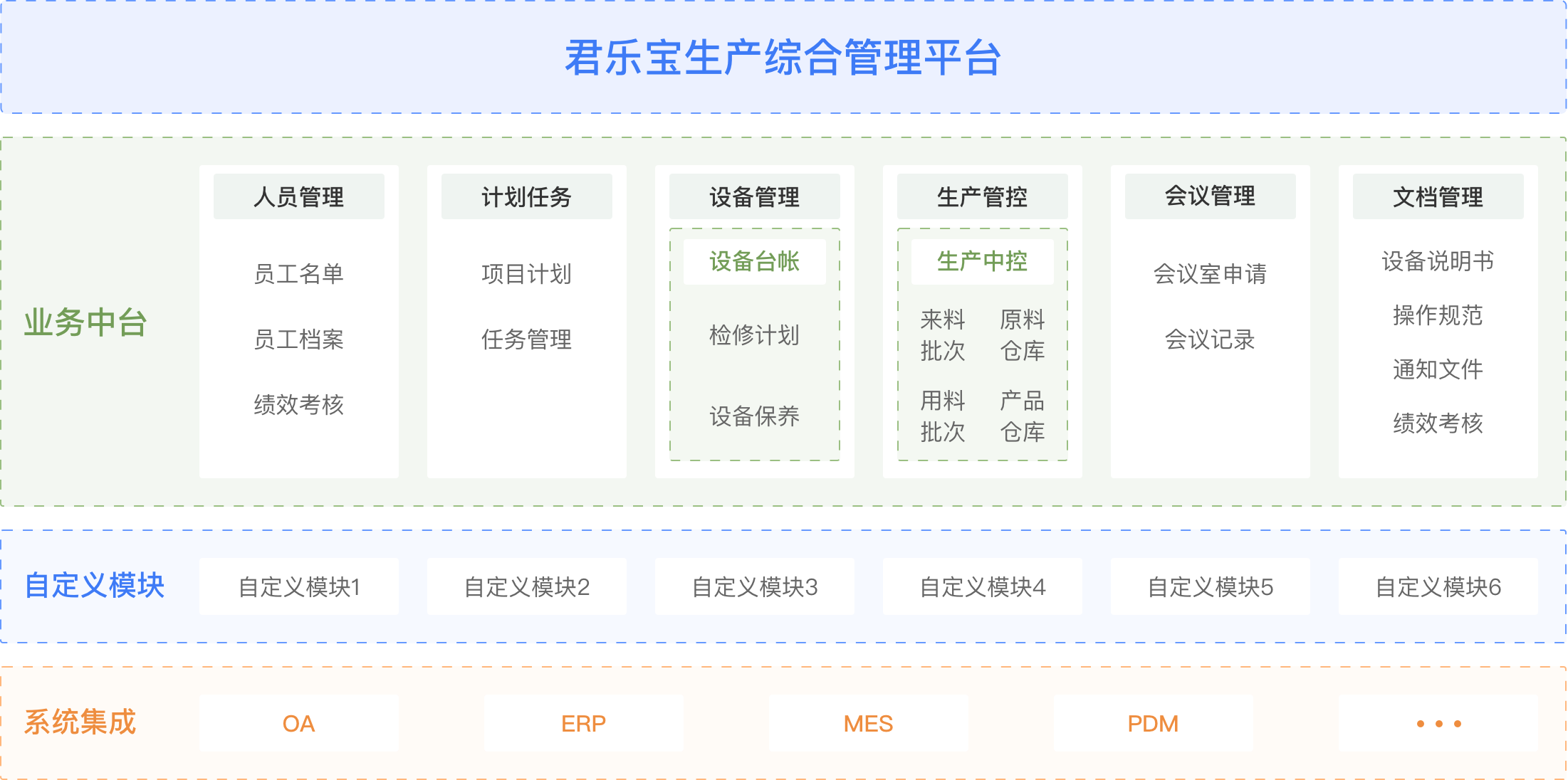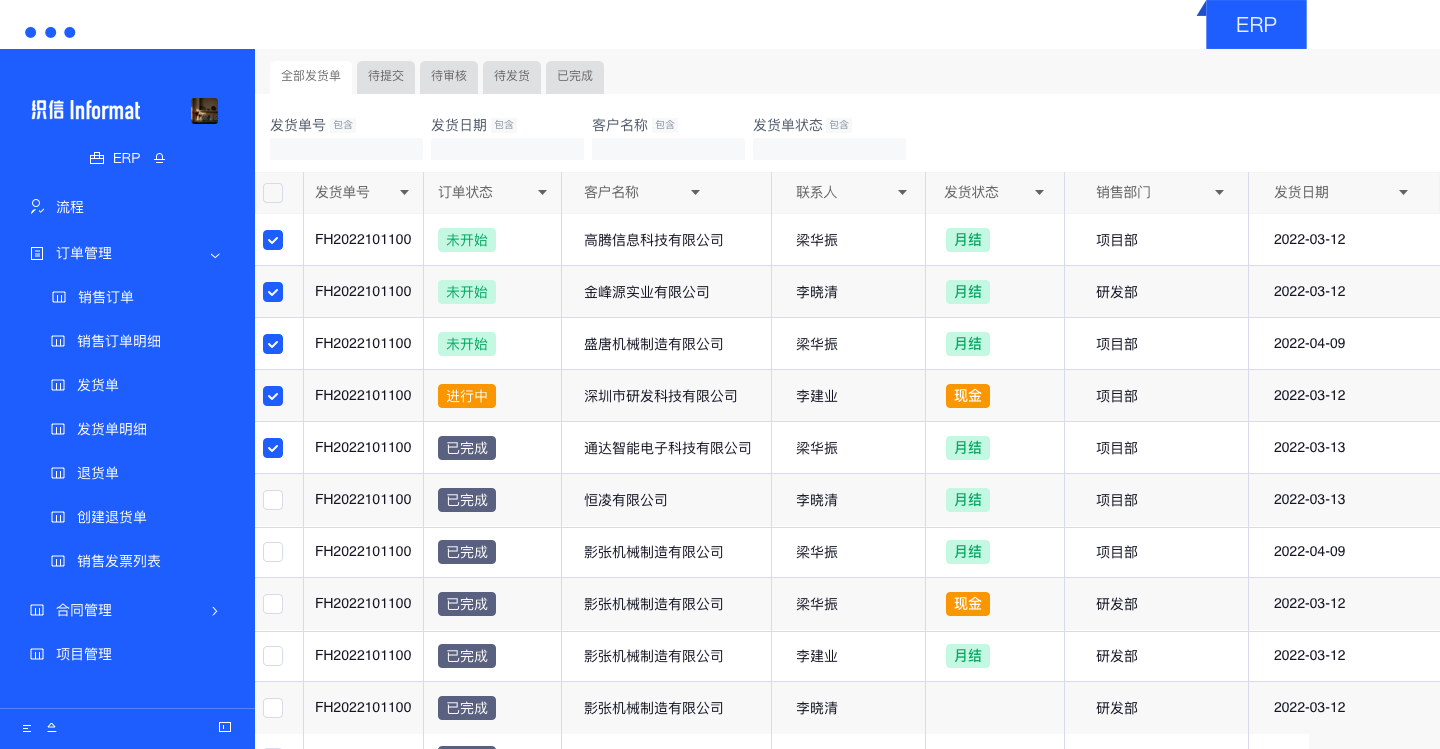foreword
Manufacturing is one of the pillar industries of the national economy. With the development of technology and digitalization, the manufacturing industry is undergoing a new transformation. The traditional manufacturing model can no longer meet the rapid changes in the market and the diverse needs of customers. Manufacturing companies urgently need to upgrade through digital and intelligent transformation to improve production efficiency and quality levels, reduce costs, and improve market competitiveness. However, for many manufacturing companies, the traditional IT system construction and development cycle is long, the cost is high, and it is difficult to meet business needs, which has become the main bottleneck restricting digital transformation.

Therefore, the emergence of low code provides a new solution for the digital transformation of the manufacturing industry. The low-code platform provides a way to quickly build applications, which can greatly reduce development costs, shorten development cycles, and improve development efficiency. At the same time, the low-code platform also has the advantages of ease of use, visual modeling, and automated coding, allowing enterprises to easily build applications that meet business needs.
In order to meet the diverse needs of the manufacturing terminal, realize the cost control of the whole process, promote the collaboration between the upstream and downstream of the industrial chain, and create a flexible and efficient production system, this article will introduce a manufacturing solution based on the Zhixin enterprise-level low-code platform. The plan mainly elaborates on the manufacturing solutions of Zhixin's enterprise-level low-code development platform from the aspects of industry status, demand analysis, solutions, business value, and customer success stories. To help manufacturing companies achieve digital transformation and intelligent upgrades .
1. Current status of the manufacturing industry
Manufacturing is an important part of the domestic economy, and its position in the industrial chain determines its importance in economic development. However, there are also some problems left over from history in the long-term development of the manufacturing industry.
1. Low synergy efficiency
The production process of the traditional manufacturing industry is usually decentralized, and each link in the production line lacks effective coordination and management, resulting in low production efficiency, high costs, and difficult quality assurance.
2. Defects in production process management
In the production process of manufacturing enterprises, there are often problems such as unreasonable production plans, irregular processes, waste of resources and materials, defective products, and production line shutdowns, resulting in low production efficiency. It has even seriously affected the operations and profits of manufacturing companies.
3. Information islands
In manufacturing enterprises, the information flow between different departments is not smooth, resulting in the problem of information islands, which affects the production efficiency and production effect of the enterprise.
4. Parts management is difficult
Parts management is usually a difficult problem, because they account for a large proportion in the production process, so the requirements for their management are also high, but in reality, there are often problems such as improper management, loss, damage and so on.
5. Supply chain risk
Manufacturing enterprises are highly dependent on the supply chain, but there are great challenges in the management and risk control of the supply chain, such as complex supplier hierarchy, untimely delivery, and unreliable quality.
6. Quality management issues
In the manufacturing industry, quality issues are a serious management problem because it directly affects the quality and reputation of products, resulting in a decline in sales and profits. Quality management is often affected by processes, equipment, and personnel.
In addition to the above common problems, the manufacturing industry is also facing many challenges with the ever-changing market demand and the increasing diversification of consumers, coupled with the continuous development of technology and the intensification of market competition. On the one hand, cost pressures are increasing, production efficiency is low, and it is difficult to meet the diverse needs of customers; on the other hand, enterprises are facing problems such as aging production equipment and management methods, and brain drain, making it difficult to maintain competitiveness. Therefore, the manufacturing industry urgently needs to carry out digital transformation to realize the intelligent and digital management of the whole process.
2. Demand analysis of manufacturing production management system
In the context of digital transformation, the manufacturing industry needs to meet the following needs:
1. Integrate various internal and external resources of the enterprise, form an overall optimized production process, improve product quality and enterprise competitiveness, and promote continuous business growth.
2. Unify management and control of intelligent production and testing equipment, realize remote monitoring and management of equipment, and improve equipment utilization and production efficiency.
3. Establish an information communication platform with suppliers and customers to realize rapid synchronization and coordination of information, so as to better respond to market demand and customer demand.
4. Improve the management quality of the production process, prevent and correct errors, and make quality management easier.
5. Help enterprises to quickly schedule production according to market demand and realize flexible production demand.
6. Improve delivery timeliness, digitalize the management and monitoring of the whole process, and improve delivery timeliness.
7. Build an industrial Internet application platform to realize unified management and control of production, operation and service.
3. Solution of manufacturing production management system
Today's manufacturing industry is highly competitive, and digital transformation has become the development trend of manufacturing enterprises. The manufacturing solution launched by Zhixin's enterprise-level low-code development platform provides a comprehensive digital control solution for the management pain points of manufacturing enterprises. The following are the details of the program:
1. Enterprise management
Enterprise management is the core management link in the manufacturing industry. Through the operating status and statistical data provided by the Zhixin platform, enterprises can fully understand the company's operating status, analyze and predict based on big data, make scientific decisions, reduce costs and increase efficiency. At the same time, the platform can also refine the management objects, assess the target responsibility to the person, and realize the overall coordination, thereby improving the management efficiency and collaboration ability of the enterprise.
2. Personnel management
Personnel management is an important part of manufacturing enterprises. Weaving letter platform provides functions for efficiently handling recruitment, leave, salary, training, performance and other businesses, which can help enterprises link people, events, data and management anytime and anywhere, realize comprehensive, timely and scientific personnel management, and effectively enhance the vitality of corporate organizations .
3. Supplier management
Supplier management is a key link in the procurement management of manufacturing enterprises. The Zhixin platform provides automated processes, reduces manual financial audit and statistical work, real-time data management and analysis, and promotes the integration of business and finance. At the same time, the platform can also quickly process expenses reimbursement, expense application and other processes to improve work efficiency in an all-round way.
4. Sales management
Sales management is an important part of marketing in manufacturing enterprises. The Zhixin platform provides the functions of quickly creating sales staff visit plans and evaluating performance, comprehensively controlling customers and project progress, and building an efficient and collaborative sales team. At the same time, the platform also provides data analysis functions, which can timely adjust marketing strategies according to market conditions, thereby improving sales performance.
5. Purchasing management
Purchasing management is an important part of supply chain management in manufacturing enterprises. Weaving letter platform provides transparent procurement process, records and manages the functions of each procurement link, and easily carries out procurement warehousing, return, and logistics tracking. At the same time, the platform also provides the function of real-time analysis of suppliers and making the best procurement options to help enterprises improve procurement efficiency and reduce procurement costs.
6. Production management
In manufacturing, production management is a very important part. Using modern technology to monitor information about products, quality, and equipment utilization in real time can improve production quality and efficiency and reduce production costs. Through the collaboration of various departments, reasonable production plans, data transparency, and smart production can help manufacturing companies to produce more efficiently and avoid resource waste and inefficiency caused by improper management. In addition, the establishment of a timely reporting system is of great help to the tracking of process flow, monitoring of production efficiency, and quality inspection. It can effectively increase the output of the factory, improve product quality, and reduce the rate of defective products.
7. Equipment management
Equipment management is an area of great concern to manufacturing companies. By regularly generating inspection/maintenance tasks for equipment, it can ensure the normal operation of equipment, improve the service life of equipment, and reduce equipment maintenance costs. At the same time, when the equipment fails, the on-site quick maintenance and automatic repair mechanism can respond quickly, follow up the maintenance progress in time, and reduce downtime and loss. Using statistical analysis of equipment data and timely reporting of equipment abnormalities, real-time monitoring and early warning of equipment status can be realized, effectively reducing equipment failure rates and improving the stability of the production line.
8. Warehouse management
In manufacturing, warehouse management is also a very important part. By updating warehouse information in real time and linking production, procurement and sales departments, the efficiency of the entire supply chain can be improved, inventory management and utilization can be optimized, and operating costs can be reduced. Automatic statistics of classified data, early warning of imminent dates, consumable goods and other information can help enterprises better grasp inventory status, adjust procurement plans in time, and reduce inventory loss and waste. In addition, warehouse management also needs to pay attention to safety aspects, such as fire prevention, anti-theft, etc., to ensure the safety of enterprise assets.
4. Business value of manufacturing production management system
1. Unified management and control equipment
The low-code manufacturing solution uses the industrial Internet of Things platform to establish data exchange standards, realize equipment information exchange, and help manufacturing companies realize unified management and control of equipment. Through data collection and analysis of intelligent production equipment in the factory, real-time monitoring and control of the production process is realized. Through the application of the industrial Internet of Things platform, equipment failures can be quickly detected and predicted, and early warning and prevention can be performed to avoid losses and delays caused by equipment failures.
2. Improve efficiency and reduce costs
The low-code manufacturing solution comprehensively improves enterprise efficiency and reduces costs through OEE control, lean management, inventory optimization and other means. Through OEE control, the whole life cycle monitoring of equipment is realized to minimize equipment failure time and improve equipment utilization. Through lean management, the overall optimization of the manufacturing process is realized, waste is eliminated, and production efficiency is improved. Through inventory optimization, accurate inventory management can be realized, and the loss caused by excessive or insufficient inventory can be avoided, and the production efficiency and smoothness of the process can be improved.
3. Rapid information synchronization and collaboration
The low-code manufacturing solution realizes rapid synchronization and collaboration of information by establishing an information communication platform with suppliers and customers. Through information sharing, companies can achieve closer ties with suppliers and customers, help companies achieve more agile production adjustments, and improve production efficiency and flexibility.
4. Improve management quality
The low-code manufacturing solution realizes the error prevention and correction of the production process system by establishing an error prevention and correction mechanism, making quality management easier. Through the comprehensive monitoring of the production process, it is possible to discover and warn of possible quality problems in the production process, and deal with them in time to avoid production delays and customer complaints caused by quality problems.
5. Flexible production
The low-code manufacturing solution helps companies quickly schedule production according to market demand to achieve flexible production requirements. Through the industrial Internet of Things platform, the real-time monitoring and control of the production process can be realized to realize the rapid adjustment of the production process. At the same time, through the production scheduling supported by intelligent algorithms, it helps enterprises achieve accurate production planning and production scheduling, and improves production efficiency and process flexibility.
5. Successful cases of manufacturing production management system customers
1. Project background
Junlebao Dairy Group is an old-fashioned dairy company in China. Founded in 1995, it has become the largest dairy product processing company in Hebei Province and a leading brand of domestic milk powder. However, due to historical reasons, certain management processes or businesses have not been linked, resulting in low overall office collaboration efficiency, which has become a shortcoming in the overall digitalization process of the enterprise, restricting the overall development process, and becoming a "dead corner" that hinders the digital upgrade of Junlebao ".

2. Customer needs
Junlebao has already invested in product development, manufacturing, OA office, project management, etc., but there are still some management processes or businesses that are not connected, resulting in low overall office collaboration efficiency. The customer needs a digital management system to optimize the processes of production management, equipment inspection and enterprise system, improve the overall collaboration efficiency and digital level, so as to accelerate the process of enterprise digital upgrade.
(1) Equipment inspection:
Equipment patrol inspection lacks an information management model, and currently still relies on Excel tables + paper manual records. This traditional manual accounting method is inefficient and prone to errors. Therefore, customers need a digital management system to optimize equipment inspection and daily work, improve work efficiency and quality, and avoid production safety hazards.
(2) System docking:
The central control of production quality needs to connect multiple processes and multiple systems, and the current data cannot be summarized in real time. The customer needs an integrated and infinitely scalable digital management system to collect and summarize data in real time and optimize production management processes.
(3) Enterprise system:
The cost of multi-system docking is high, and the new system does not conform to Junlebao's established process, and system procurement is facing difficulties. Therefore, customers need a digital management system that can seamlessly connect with the original OA, ERP and other systems, and can customize application modules according to their own business characteristics, so as to quickly realize digital upgrades.
3. Solutions
In order to meet the needs of Junlebao, Zhixin low-code platform provides the following solutions:

(1) Digital upgrade:
We use the letter-weaving low-code platform to build a personalized demand system, so that daily work such as equipment inspections and performance appraisals bid farewell to the traditional manual ledger mode, and adopt a digital management model to comprehensively improve the efficiency and quality of daily equipment inspections and eliminate hidden dangers in production safety.
(2) Multi-system connection:
Zhixin's low-code platform can also integrate the original OA, ERP and other systems, set up data and business platforms, realize real-time data collection and aggregation, solve the "digital blind spots" that cannot be covered by the original system, and accelerate the process of digital transformation and upgrading of enterprises .
(3) Personalized implementation:
The Zhixin low-code platform can customize and develop application modules according to the specific business needs and processes of Junlebao, so that the system can be completely built according to the original business processes and habits, realize personalized implementation, and improve the use experience and work efficiency of enterprise employees.
4. Program effect
(1) Digital production:
Adopting the digital management mode, the daily work such as equipment inspection and performance appraisal has realized information management, which has comprehensively improved the efficiency and quality of daily equipment inspection, and eliminated hidden dangers in production safety.
(2) Seamless connection with ready-made systems:
Realize the connection of multiple systems through the Zhixin low-code platform, speed up the process of digital transformation and upgrading of enterprises, solve the "digital blind spots" that cannot be covered by the original system, realize real-time collection and aggregation of data, and improve the efficiency of enterprise decision-making and operation. .
(3) Build a comprehensive management platform:
The comprehensive management platform built through the Zhixin low-code platform realizes the integrated management with production management as the core, makes the various management processes and businesses related, improves the overall office collaboration efficiency of the enterprise, and promotes the digital transformation and upgrading process of the enterprise.
6. About Zhixin enterprise-level low-code platform
Zhixin enterprise-level low-code platform is a visual development platform based on micro-service architecture and oriented to enterprise-level applications. It provides enterprises with the ability to quickly build business applications, helps enterprises shorten application delivery cycles, and improves R&D efficiency.

Weaving letter enterprise-level low-code platform has the following characteristics:
1. Wide coverage: Through the integration of "data, process, interaction" fine-grained functional components, various business scenario information models are realized, such as approval, workflow, statistical analysis, etc.
2. Strong scalability: Provide enough open capabilities to support the integration of third-party services in the form of "code development, API interface, and extension packages" to improve application scalability.
3. Easy maintenance: Simplify application development and maintenance by reducing code writing and providing automated tools, which is convenient for user tracking and management, and greatly reduces maintenance costs and risks.
4. Support complex scenarios: support the digital upgrade of various management systems, such as ERP, PLM, OA, CRM and project management. Help enterprises improve management efficiency and effectiveness.
5. High availability: supports distributed architecture and cluster deployment to ensure system stability. Heterogeneous system integration improves system flexibility and scalability.
6. Private deployment: Enterprises can customize the development and configuration of digital systems to improve adaptability and scalability. Privatized deployment ensures data privacy and security.
Conclusion:
In the modern manufacturing industry, digitization and intelligence have become the only way for enterprises to enhance their competitiveness and achieve sustainable development. Zhixin low-code can help enterprises quickly build intelligent production systems and digital management platforms, improve the production efficiency and management level of enterprises, and promote the continuous growth of enterprises. Zhixin low-code has the advantages of visual development, scalability, safety and reliability, agile development and independent deployment, etc. It can meet various complex application scenarios and needs in the manufacturing industry, and provide strong support for the digital and intelligent transformation of enterprises. We believe that with the deepening of digitization and intelligence, Zhixin low-code will become an important tool and platform for the digital transformation of the manufacturing industry, helping enterprises better adapt to market changes, enhance core competitiveness, and achieve sustainable development.